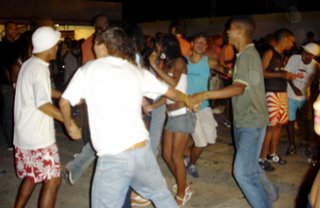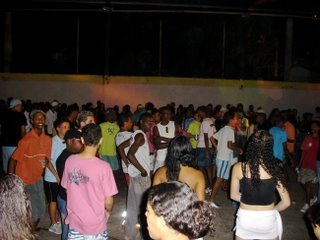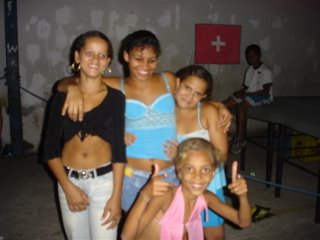
It happened. My first baile, Friday night at Cantagalo, without incident. And yet, it left me with vertigo, staring down the equation of 2000 kids x 60 feet of speakers x 500 bailes a night x 30 years of history = me standing in a corner scribbling things in a notepad trying (vainly vainly) to make some sense of it (to me at least, it made perfect sense to everyone on the dancefloor) and trying (with much more success) not to offend any of the (likely) heavily-armed
traficantes running the show.
And while my experience at Cantagalo very well may not have been typical -- wedged between posh Ipanema and Copcabana, it attracted plenty of partygoers who weren't
favelados, and I've been told up in the Zona Norte, away from postcard Rio, things get rougher -- there's still plenty to say about it, and plenty more to wonder about. If anything, the concept of a baile at all was entirely overdetermined (in the Nietzschean sense of
überladen, overwrought with influences, too much expectation to know what to expect at all). Was it really going to be 12 year olds snorting massive lines of coke (read that in a Diplo interview, can't find it on Google though) and
waving guns in the air? More importantly, was I going to be disappointed if it wasn't?
I showed up early (11:30ish), interested in seeing the process from beginning
to end. It was held inside the
quadra, a gym-like space where the local
escola de samba practices. Following the wandering curves up the hill, not necessarily knowing where I was going, having been told so many times that favelas are dangerous (esp. alone, esp. at night), it was pleasantly disarming to find nothing more than . . . a street festival, more or less. Residents had set up stalls and booths to sell food and drinks, everyone was out socializing, kids kicking around soccer balls. What the baile appeared to offer was a social outlet for the community, the
quadra as a focal point (one of the few open spaces amidst the twists & turns of the
becos). Following
Bo's advice, even though this was obviously the spot (as if the speakers didn't give it away), I asked some kids, the "eyes & ears" of the favela, "
onde fica o baile?" "
aí, na quadra!" And so they knew: the gringo wasn't there to buy drugs or cause trouble, just came for the party. Sure enough, an hour later when the music came on, the same kid found me in the crowd and told me it was starting.
I met up with
MC Gringo (who you can hear on the
fourth Maddecent podcast), who's turning into my personal tour guide of the
movimento do funk (funk scene). He seemed to know all the major players there and hyped his new single -- or hit, as he preferred to call it -- to the DJs, "
Mulher para um real" ("Woman for one
real" -- same kind of playful/ironic sexism that's constant in American hip-hop. whether it should be condoned is another question, but I don't think it's hateful misogyny by any stretch. I'll get an mp3 when I can; he gave all his CD-Rs to the DJs, who are obviously more important than me).
There was plenty of milling about and networking before the party got going -- like any hard-working MC, Gringo wanted to secure a gig that night, although it ultimately didn't come through. Finally, by about 2 am, it took off, as a steady stream of people climbed the hill, taxis struggling to make it up the incline. There were two DJs representing two
equipes (literally "teams," but soundsystems as we'd understand them), each packing their own massive bank of speakers (see pic at top). When Bo wrote, "bring earplugs if you care at all about your hearing. it is loud as fuck", he wasn't kidding. Standing in the space between the two soundsystems facing one another takes "feelingful" to a whole new level. This is bass that makes your chest thump with every beat (not to mention your ass -- as the grinding crowd evidenced, funk does go straight to the booty).
The bill for the night included Adriana's friend
DJ Sany of the Pitbull Crew (pictured below), DJ Fernandinho of Big Mix Radio (
DJ Marlboro's outfit), MC Leca (from Zona Norte, sang
proibidão), and MC Daisy (went on early, don't know much about her).


Mostly Sany and Fernandinho traded takes at the decks all night. Sany was on CD-Js and Fernandinho played some pretty battered and bruised looking
mini disks (with Portuguese on the disks so faded I couldn't even begin to read any track names). Definitely an all-digital scene; nary a piece of vinyl to be found. As for song selection, it was clear that Sany played the more obscure, rawer tracks while Fernandinho, as a representative of Big Mix, played more radio-friendly ones. It was easy enough to discern sonically (Sany's tracks had less samples, more vocals, relied more on the minimal beat structure underneath it all), but also reflected my obvious lack of knowledge. I got really excited when I recognized any song, given my limited exposure to funk in the grand scheme of things. But of course, anything I recognized was anything that was popular enough to creep north of the equator. The likes of, for example, the song on
Dr. Auratheft's mix that samples the
Flamengo anthem. Given that Flamengo won the
Copa do Brasil last week, it was an obvious crowdpleaser, but as Gringo made clear, to any real
funkeiro, it was a totally overplayed track.
When the two female MCs took the stage, meanwhile, they just rapped over whatever beats the DJ was playing at the time -- no chance of the DJ queuing up your hit single to wow the crowd with. The ephemerality of freestyling, music that can be consumed only by those present, the fluid music of making-do. Also the consistency of funk's tempo, the expectation that an MC knows all the tracks that might be played anyway, can readily adapt.
There was a little more stability, however, to a choreograph dance sequence that took over at one point. I'll be honest in that it reminded me of something along the lines of the Backstreet Boys (five guys performing synchronized dance moves in a very music video-esque style), but it seemed to get the crowd excited.
Lastly, it's worth mentioning an odd interlude that took place about halfway through the baile. The house lights were thrown on and a young boy (8, 9 years old?) sang a gospel song, followed by a quick bit of proselytizing from an evangelical preacher. Obviously the
traficantes had to approve this, and I wonder about their motivation. Some conscious or subconscious penance for their own actions? Attempt to put a positive spin on the baile for the members of the community who find it distasteful? Whatever the rationale, it cleared the room quickly. Religion and raunch, I'm afraid, don't mix. But it did accentuate the role of the baile as a community event, willing to incorporate messages that seem to contradict its primary discursive purpose: glorify the favela as it relates to the drug trade.

By about 5 or 6 am, the sun just peeking over the Atlantic, the crowd thinned and the music eventually came to a halt. I hung around and chatted with Céliu (MC Leca's husband) and Faviano, who had the thankless task of dismantling their
equipe's soundsystem in the wee hours of the morning.

They were going to let me accompany them to their favela in Zona Norte while they set up for Saturday night's baile, but the impending rain ended up canceling the party. I hung around nonetheless for the chance to take pictures, which I wasn't allowed to do during the party proper. If I understood correctly, I believe I have permission to record some audio and video this coming Friday. It'll be delicate anyway I slice it, and probably involve clearing things with the
dono do morro ("don of the hill," the CV's [Comando Vermelho, the drug gang that runs Cantagalo] local chief). A little baile bootlegging would be a real treasure, however, so I'm going to do my best to make it happen.

As dawn turned into daylight, I made my way down the hill bewildered, trying to piece together what I had just witnessed and my relationship to it. First, the most obvious question: What the hell am I doing here? It's all well & good in the abstract, but showing up to "study" somebody else's party music, to go to their party and see them not as subjects but as a bunch of people just having a good time on a Friday night . . . it seems more than a bit patronizing (esp. given the obvious inequities of class and the history of American-Latin relations). Gringo, without fingering me directly, dismissed those who try to intellectualize funk. "It's just primitive music," he insists. But lying in bed reading Paul Sneed's thesis (which I have permission to post! expect a later entry with much commentary; it's a masterwork) because the adrenaline of an all-nighter had not yet subsided, I began to appreciate the crux of his success: He was not an outsider looking in, but rather did his best, without reaching the point of parody, to become a
funkeiro. He lived in Rocinha, he went to bailes, he danced, and he waited until the next day before jotting down observations. I'm afraid that my current situation -- time's wingèd chariot at my back, et al. -- won't permit me the same immersion, but it's encouraging to read his insights knowing he obtained them as subjectively as possible. Knowing that his belief in funk's socio-cultural role did not come from holding up a microscope to it.
Then, recapping the night, question number two:
Coke. Guns. Booty. Beats. (to link for the second time this post.) Is it really "
the most excitingand dangerousunderground club scene in the world"? Or, as I suspect the article really means, the most exciting because it's the most dangerous. While the musical novelty of "punk rock + new wave samples + little kids screaming + miami bass" was enough to lure plenty, those who read more about the scene were invariably hooked by the lurid tales of favela life. The predominate attention bailes got up until the music itself became popular was over easily sensationalized phenomena like Corridors of Death and the death of Tim Lopes (of course I'm not saying these never happened, nor am I trying to brush off the awful severity of them, but certainly these events receive far more press than Friday night's baile at Cantagalo, where lo and behold, no one was killed and everyone seemed to just have a good time). But music fans have flipped the reception of those events around, so that such attributes have exoticized bailes funk. And when safely consumed up North, it quickly falls into the comfortable status of
radical chic (or
Favela Chic, for that matter).
I freely admit falling into the same trap. I'm not going to hide my roots: the world of the favela is about as far away from
a planned community in suburban Maryland as you can probably get, and as such I find it a lot more interesting of a place than where I grew up. However, I think it's important to appreciate the favela not just as some exotic hotspot (the Blender article actually tries to call the reality worse than
City of God, which to me seems like a totally baseless claim), but also as a community. And so I tried to focus on the social role the baile plays, as far as I could see it, before turning to pistols & pot. So what did I see?
- Guns: Before, the police drove through the center of the pre-party crowd, a machine gun pointed out the window. During, I saw a pistol tucked into the waistband of a traficante after he took his shirt off (no indication he did so to show off the pistol, it was just hot inside). As the crowd headed home, one man had his assault rifle casually pointed in the air. After, the police made another patrol on foot, pistols unholstered. Always displays of power, the police and the drug gangs in a constant battle over authority, yet the police making a more visible display of it, fingers on the trigger, a click away from death. More guns in the hands of the police, though, and still more on a daily basis walking around the city (the cops at Maracanã stadium during a soccer game last weekend had far more firepower than I spotted in Cantagalo).
- Drugs: There was a boca-de-fumo (alley where drugs are sold) across the way from the quadra. Plenty of people were smoking joints outside. Nothing harder that I could see, and certainly no one excessively young using it. In this regard, probably tamer than some nightclubs around town, or places I've been in the States/Europe.

- Booty: Hiphuggers or a short denim skirt, a halter top, and washboard abs made for standard female attire. The dancing was suggestive, full of close contact. But this is a city where the world's biggest Carnival celebration includes topless women in thongs parading in front of millions of people. Puritan bluster can get over itself, this was nothing out of the ordinary, even if the girls may seem younger by our standards (we also live longer; the night got sobering when Gringo casually mentioned that a 30-year-old MC is considered old & has probably outlived most of his contemporaries).
__
August is here, I've been here longer than I have left, and my Portuguese class will be over tomorrow. First baile under my belt, and many more to go. Plus rado stations (Rocinha didn't pan out last week, some other time though), studios, recording spaces, interviews with MCs and DJs, commentary/analysis, more beats (going to the Uruguaiana market to buy some
proibidão on Saturday). It's hot & polyglot (
/rupture's phrase, not mine, although they're turning into my watchwords), and I aim to keep it that way until winter turns back to summer at the end of the month.
MC Gringo - "Gringaiada Demorou"Labels: baile, favelas, funk, rio











